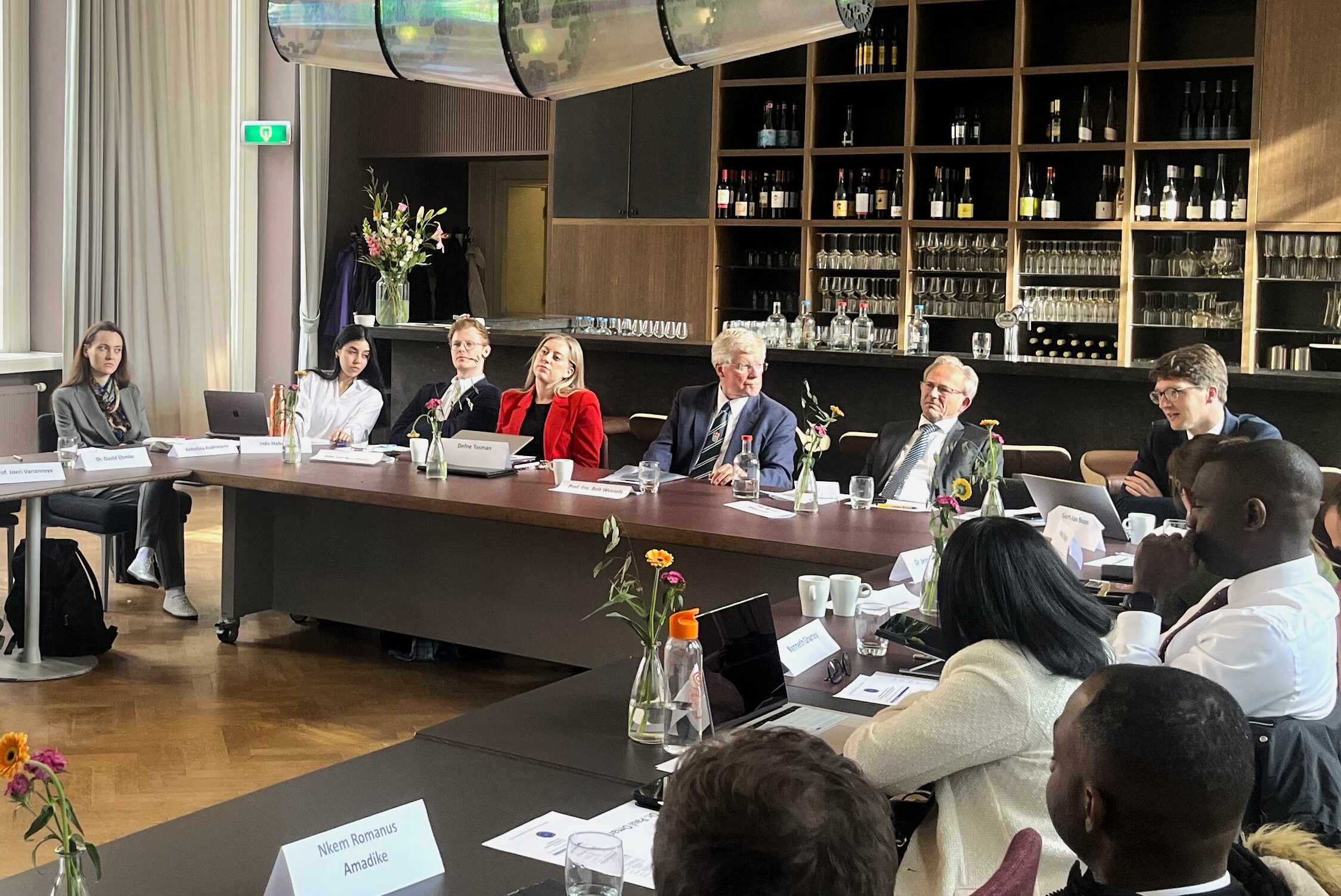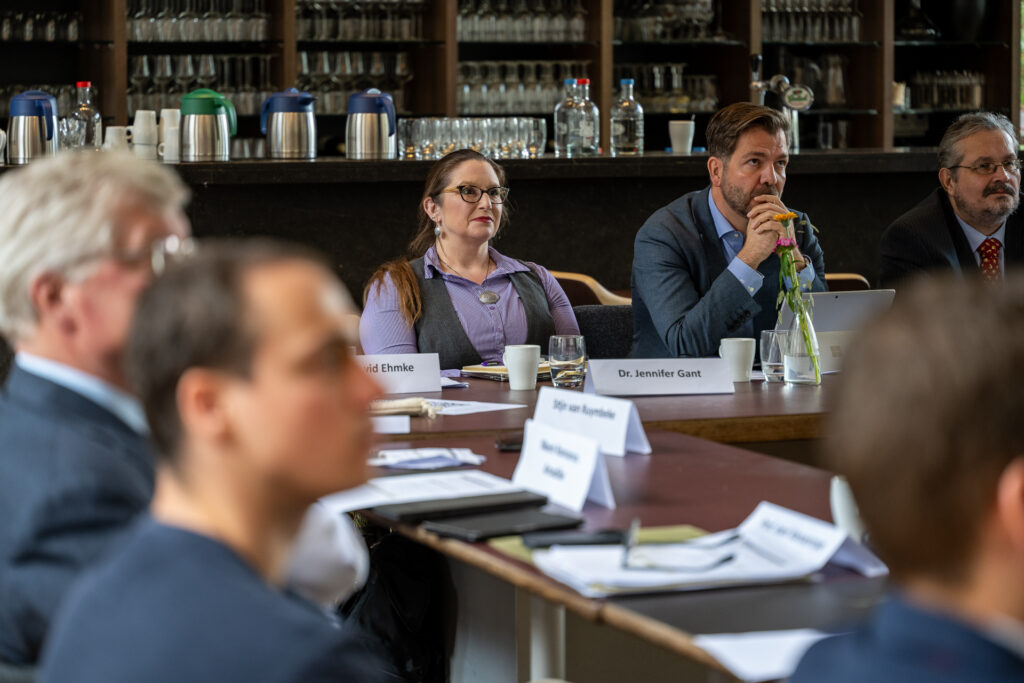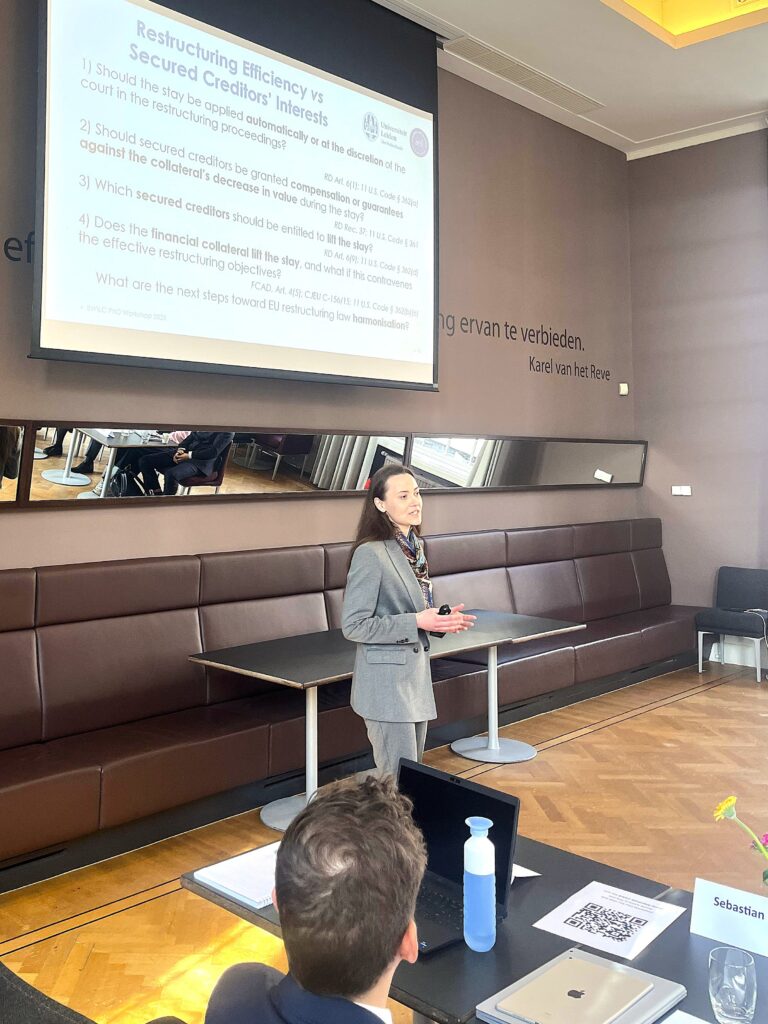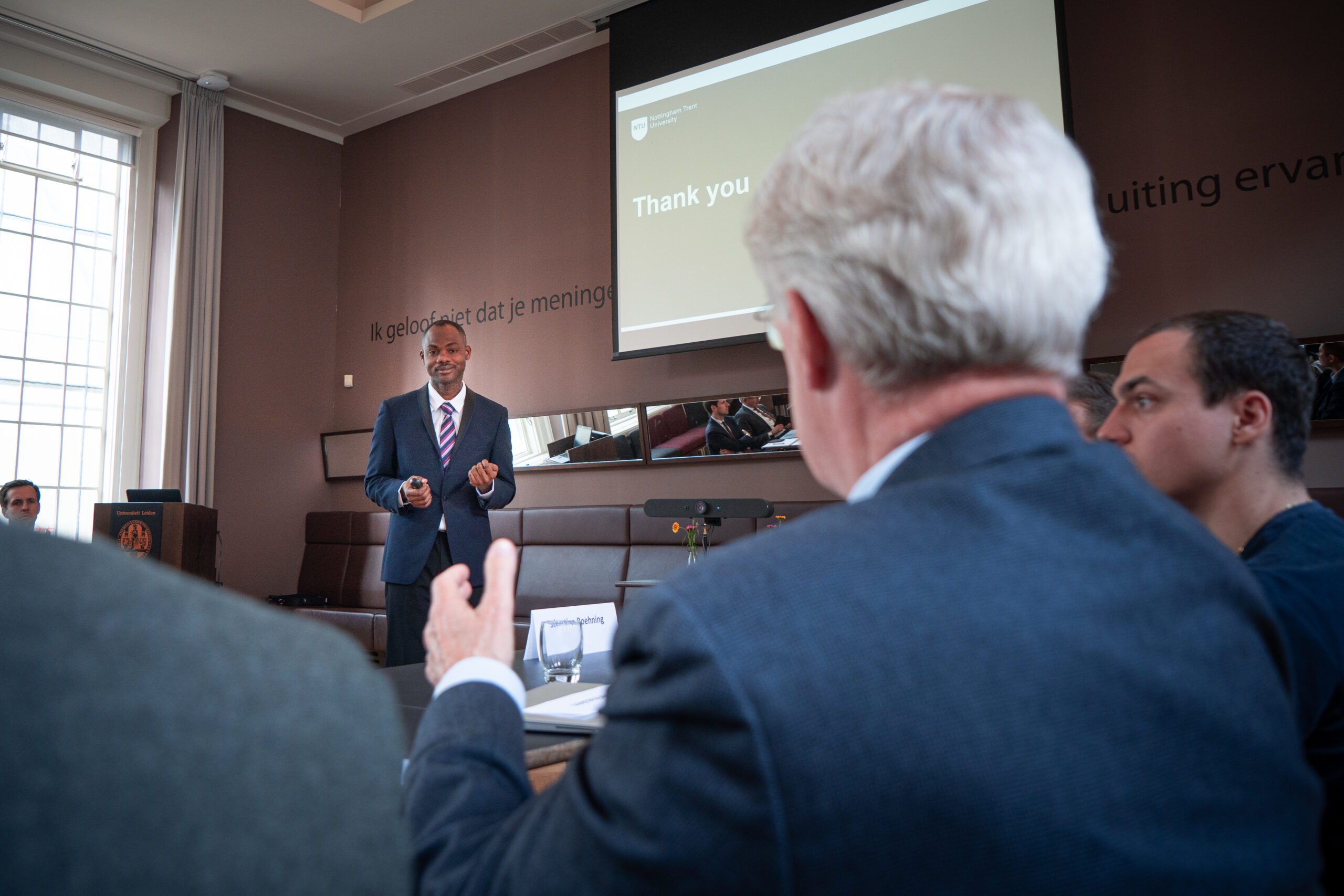Inès Habassi[1]
On 7 and 8 May 2025, the 7th edition of the Bob Wessels Insolvency Law Collection Foundation (BWILC) PhD Workshop took place at the University of Leiden, The Netherlands. Following the 2024 edition in Vilnius, the workshop returned to its home base in Leiden this year. True to tradition, this edition provided a valuable opportunity to attend and participate in a comprehensive colloquium, bringing together young researchers from different backgrounds to discuss their findings with field counterparts, along with a large variety of experts in international and European insolvency Law. Within the historic walls of the Academy Building, thirteen PhD candidates took the floor to share their unfolding research journeys, sparking vibrant dialogue with one another, senior scholars, and practitioners.
The BWILC PhD Workshop remains one of the rare spaces dedicated exclusively to fostering dialogue among early-career scholars in this field who are working on their doctoral dissertation. As in previous editions, the workshop also included a prize competition, with awards for the most convincing research presentations and the best poster presentation.
For a photo report of the workshop click here.
Day 1 – Navigating evolving frontiers of cross-border restructuring and insolvency law
Professor Reinout Vriesendorp (University of Leiden, The Netherlands) opened the 7th edition of the workshop with a welcome address on behalf of the BWILC board. He underscored the importance of fostering networks among emerging scholars in the field of insolvency and restructuring law, incentivising participants to embrace the workshop as a platform for scholarly exchange and collaboration. Following this, brief introductions were made by all attendees.



Session I:
Cross-border recognition of restructuring proceedings
The academic program opened with a presentation by Sebastian Boehning (Fulda University, Germany), titled Recognition of Preventive Restructuring Frameworks from Third Countries – Theory, Dogmatics and Practice.
Sebastian investigated whether and how preventive restructuring decisions from third countries such as the UK should be afforded recognition under German and EU law. His presentation demonstrated how, in current German legal practice, preventive restructuring frameworks tend to fall into a grey zone between insolvency and civil law regimes for cross-border recognition. However, they are not always well suited to address the specificities of preventive restructuring.
To further develop pathways for the recognition of similar proceedings, primarily based on the European Insolvency Regulation (EIR) or German domestic law, Sebastian introduced a broader conceptualisation of restructuring proceedings. He argued that this expanded definition would, in turn, mitigate the grounds for refusal. However, he cautioned that any such development must be carefully gauged in light of policy concerns, particularly the need to protect stakeholders’ rights, to avoid significant reservations.
The presentation was the object of lively exchanges focusing on whether restructuring proceedings should be treated as a distinct legal category, rather than only an extension of insolvency proceedings. In this regard, participants discussed how to balance universalist and territorialist approaches, particularly concerning the treatment of secured creditors’ rights in cross-border restructuring.
Comparative perspectives on pre-pack frameworks
After a break, the workshop resumed with a presentation by Xingyu Tian (University of Leeds, England) on The Impact of Administrative Intervention on the Chinese Corporate Reorganisation Regime: The Past Decade of Pre-Pack Administration in China.
Xingyu traced the evolution of pre-pack practices in China against the background of Chinese Bankruptcy Law reforms. He compared Chinese practice with UK and US pre-packs, explaining the unique administrative elements of the Chinese approach through a focus on the Shenzhen and Wenzhou models.
The Chinese pre-pack framework currently faces challenges in ensuring transparency, allowing/facilitating coordination among creditors, and managing the lingering influence of administrative intervention. Xingyu argued that the Chinese Enterprise Bankruptcy Law, due to be reformed, would benefit from greater alignment with international practices. However, he emphasised that these must be preserved adaptations to the particularities of the Chinese legal and economic context.
The workshop participants subsequently discussed the extent to which administrative involvement undermines or enhances the outcomes of restructuring proceedings, as well as how the varying definitions of pre-packs across jurisdictions complicate comparative analysis.
Session II:
Law and technology in insolvency processes
The afternoon continued with a joint presentation by Aruna Audenaert and Stijn van Ruymbeke (Ghent University, Belgium) on artificial intelligence, titled Decision Support in Commercial Courts: The Key to Proactive and Precise Identification and Evaluation?
Aruna and Stijn presented their project, which uses AI to support the chambers for companies in difficulty in the early detection of financially distressed companies. The system enhances the analysis of annual accounts, so-called “red flags”, and other relevant indicators, making the court’s decisions more efficient. The project is developed in collaboration with the Business Court of Antwerp.
Their model, based on an ensemble machine learning approach (XGBoost), supports but does not replace human decision-making. Subsequent discussion touched on the potential of such tools to enhance court efficiency while emphasising the need for effective safeguards. Comparisons were also drawn with more automated approaches in China and India.

Balancing creditors’ rights and restructuring efficiency
Followed a presentation by Anhelina Andrieieva (Mykolas Romeris University, Lithuania) titled A Stay of Individual Enforcement Actions and Exercise of Secured Creditors’ Rights in Restructuring Proceedings.
Anhelina examined the fine balance that must be struck between ensuring the efficiency of restructuring proceedings and the protection of creditors’ rights. Her presentation drew comparisons between Article 6 of the EU Preventive Restructuring Directive and the automatic stay provisions of Chapter 11 of the US Bankruptcy Code.
The presentation led to a lively discussion of the strategic use of such stays, the risks of abuse, and how legal frameworks can best balance and simultaneously promote restructuring goals and creditor protection.
The Role of Restructuring Experts in Safeguarding Creditors’ Interests
The next speaker, Anne Verboom (University of Leiden, The Netherlands), discussed A Dutch Perspective on the Role of Restructuring Experts in Preventing Abuse.
Anne presented preliminary findings from her empirical research into the role of restructuring experts under the Dutch implementation of the Preventive Restructuring Directive. Her fieldwork allowed for a thorough scrutiny of the discrepancy between black letter law and law in practice, with specific attention directed towards the role of experts in ensuring that abuse is prevented and creditors’ interests are protected.
Anne’s research journey unfolded how experts’ perceptions, values, and external constraints, including factors such as time, pressure and costs, shape their practices to a significant extent. The discussion addressed the need for clearer guidance and transparency regarding the expert’s role and duties.
BWILC Lecture: The Risks of Excessive Debtor-Friendliness
To conclude the first day, the annual BWILC Lecture was delivered by Dr. Dr. David Ehmke titled When Debtor-Friendliness Becomes a Problem.
The lecturer dealt with the inherent obstacles posed by the recent trend in debtor-friendly insolvency regimes. While David stressed the necessity of allowing for early intervention and ensuring transparency, he argues that leniency can, to a certain extent, hinder oversight and enforcement, amounting to significant issues in the event of fraudulent conduct.
In that sense, he reiterated the importance of maintaining institutional safeguards and oversight functions, even within debtor-in-possession frameworks. His talk was the source of a larger debate focusing on seeking the appropriate balance between facilitating restructuring and ensuring accountability for debtor-led proceedings.
Day 2 – Rethinking frameworks and actors in cross-border and preventive restructuring
The second day of the workshop began with a strong international lineup of presentations addressing emerging questions in comparative and cross-border insolvency law. Professor Stephan Madaus chaired the morning session.
Session III:
Reassessing the Role of Deposit Insurance in Bank Resolutions
Ishana Tripathi (O.P. Jindal Global University, India) opened the second day of the 2025 BWILC PhD Workshop with her research titled Reassessing the Role of Deposit Insurance in Bank Resolutions.
Her thesis mainly revolved around how the deposit insurance function develops and works in the framework of India’s resolution for banks and financial institutions. Ishana gave detailed insight on the different tools available for the resolution of such an issue, including liquidation, mergers, bail-ins, and reorganisations.
In addition, she offered a frame for the scope of India’s current deposit insurance scheme, whereby deposits up to INR 500,000 (Indian Rupees) are covered per bank.[2] In this context, Ishana also touched upon the inherent failures of the 2017 Financial Institutions and Deposit Insurance Bill, encompassed under ongoing legislative plans directed towards reshaping deposit protection mechanisms.
The presentation followed up on engaging exchanges around the practical implications of resolution frameworks parallel to the ones used in India and raised concerns over the effective protection of depositors in jurisdictions where liquidation remains the main canon for resolution cases.



The evolving Indian cross-border insolvency landscape
Alok Verma (Tel Aviv University, Israël) continued with his presentation on Cross-Border Insolvency in India: The Role of Comity in the Absence of a Legal Framework.
He uncovered the failures and shortcomings of the current Indian statutory framework in providing a comprehensive approach to cross-border insolvency disputes. He subsequently explained how Indian courts tend to focus excessively on common law principles, notably relying on doctrines of comity and modified universalism, rendering their methods ill-suited for a significant proportion of foreign insolvency cases.
Alok also discussed the numerous challenges arising from the branch operation of a non-registered foreign company in India, which seeks recognition of its proceedings. In such circumstances, national courts have such discretion that the application of company law often becomes broad and inadequate.
His presentation put emphasis on the ongoing debate on the adoption of the UNCITRAL Model Law in India and the controversy surrounding reciprocity-based approaches and further flexible recognition regimes. The audience engaged in a thoughtful discussion on the limits of the committee mechanism in Indian winding-up and restructuring procedures, and whether a statutory solution is now urgently needed.
Session IV:
The role of shareholders in preventive restructuring frameworks
Next, Lauryn Daville (Jean Moulin-Lyon 3 University, France) presented her research on The Shareholder in Preventive Restructuring Frameworks: From Expectation to Reality.
Lauryn’s research mainly focused on the role shareholders hold under the transposition of the 2019 Preventive Restructuring Directive (PRD). On the one hand, the PRD seeks to practice a weighting exercise between mitigating the obstacles shareholders might face and protecting their relevant legitimate interests. On the other hand, Lauryn highlighted how the French system has yet to balance these two aspects properly and remains fairly inclined towards the traditional protection of shareholder rights.
To substantiate her argumentation, Lauryn relied on how French law impedes the full cram-down of equity holders to a certain extent, which in turn would allow them to prevent restructuring outcomes even when it is not economically legitimate. She then proceeded to bring our attention towards a renewed alternative that consists of broadening the scope of the definition given to affected parties, along with a further flexible use of pre-emption rights.
Finally, her presentation served as a cornerstone for lively discourse on the definition given to shareholders across jurisdictions, particularly in respect of the inclusion of preference shareholders. The discussion also touched on the treatment of SMEs, which further complicates the issue.
The case for sectoral insolvency frameworks
Noor Mendonck (Ghent University, Belgium) took the floor next and presented her research titled Sectoral Insolvency Frameworks: Why Certain Sectors Require Tailored Approaches.
Her thesis focuses on the limits inherent to traditional insolvency regimes in respect of the protection of public interests and the guarantee of continuity for vital services in critical sectors, including banking, insurance and infrastructure. Noor intends to examine whether sectoral frameworks could offer a solution to these limitations and, if so, how such frameworks might take shape through more tailored rules for intervention and resolution.
Her presentation stirred discussion on whether such approaches should be extended to other industries, and on the limits of adapting general insolvency principles to sector-specific needs.
Non-adjusting creditor protection and internal asset shielding
Closing the fourth session, Jari Vermeulen (KU Leuven, Belgium) presented on Non-Adjusting Creditor Protection Against Non-Corporate Law Techniques of Internal Asset Shielding.
He offered tailored scrutiny over the way creditors can be protected against internal asset-shielding mechanisms that escape the structures set by traditional corporations. Jari emphasised the existing complexities surrounding the cross-shielding application of equivalent treatment and how legal frameworks can adapt to ever-changing business practices.
The discussion panel subsequently followed to highlight the significance of ensuring transparency and fairness in asset partitioning, along with the potential challenges that further creative structuring techniques can pose.

Crypto-assets and cross-border insolvency in Nigeria
After the break, Nkem Romanus Amadike (Nottingham Trent University, England) presented his research on Crypto-Assets, Crypto-Business, and Cross-Border Insolvency Issues: A Nigerian Perspective.
He offered insight into the pressing challenges fostered by the rapid emergence of crypto-assets-related issues within cross-border insolvency frameworks. Nkem gave a comprehensive analysis of the unresolved ambiguities for the definition given to crypto-assets and the inherent complexities of determining their location. This latter issue is undoubtedly tied to the existence of crypto-assets on distributed ledgers rather than being secluded in a physical and easily jurisdictionalised form.
Nkem used the example of Nigeria to further exemplify these issues in a jurisdiction where the territorialist approach is vastly predominant and in which high emphasis is put on reciprocity principles. He argued that this approach is increasingly ill-suited to the realities of crypto-business. He called for a more flexible application of modified universalism and clearer guidance on the treatment of crypto-assets in insolvency.
The presentation led to an exchange on the broader global need to rethink the role of COMI (centre of main interests) in crypto-related cases, and whether traditional territoriality can survive in this new landscape.
Arbitration as a tool for cross-border insolvency
Kenneth Ghartey (Royal Holloway, University of London, England) then presented an innovative proposal in his talk Arbitral Modified Universalism: Arbitration in Aid of the Universalist Enterprise in Cross-Border Insolvencies.
Kenneth challenged the traditional view that arbitration and insolvency are fundamentally incompatible. His core idea relied on redirecting the conceptualisation of arbitration to perceive it rather as a tool offering increased flexibility in addressing universalist approaches to cross-border insolvency. He therefore introduced the concept of ‘arbitral modified universalism’, which is built around an agreed-upon consensus between parties to refer certain aspects of the insolvency proceeding to arbitration. This is aimed at enhancing legal efficiency, flexibility in resolving the relevant dispute and confidentiality.
While he conceded that national courts will most likely always retain significant oversight, Kenneth highlighted the complementary endeavours that arbitration could offer in respect of insolvency proceedings. His research sparked a multifaceted discussion on the potential obstacles that incorporating arbitration mechanisms into insolvency frameworks would create, both in practice and from a theoretical perspective. In particular, the cross-jurisdictional feasibility of this approach was examined.
Prizes and closing
At the closing of the workshop, participants reconvened for a final meeting and the announcement of this year’s BWILC PhD Workshop prizes. During the conference dinner at Scheltema in Leiden, Professor Reinout Vriesendorp awarded the prizes for the most convincing presentations and best poster:
- First prize: Kenneth Gharthey
- Second prize: Sebastian Boeming
- Third prize: Anne Verboom
- Best poster prize: Noor Mendock
The BWILC board expressed great satisfaction with the quality of this year’s workshop and the stimulating exchanges that had taken place. Plans are already underway for the next edition of the workshop in 2026.

[1] Inès Habassi is an exchange student at Leiden University, Faculty of Law, The Netherlands, and a full-time third-year bachelor’s student at Sciences Po Paris, France.
[2] Roughly around EUR 5,200.


